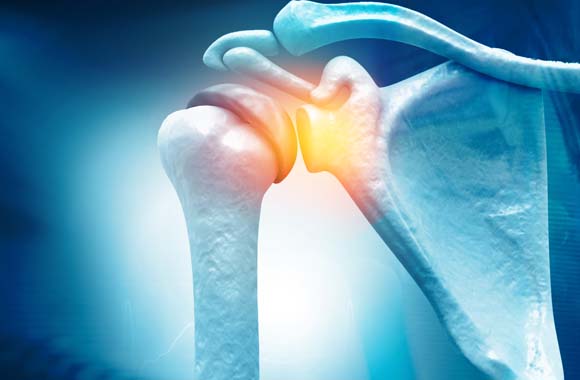Partial-thickness tears are usually treatable with physical therapy, corticosteroid injections, over-the-counter pain medications, and rest. However, surgery is often recommended for a rotator cuff tear when:
- Symptoms of pain and arm weakness have persisted over six months
- Tear is larger than three centimeters
- Significant loss of function is present
- You are a competitive athlete in a sport with repetitive overhead motions
- Tear was caused by an acute injury

Diagnosing a Rotator Cuff Tear
Symptoms associated with a rotator cuff tear often consist of:
- Dull ache deep in the shoulder
- Difficulty reaching behind your back
- Arm weakness
- Popping or clicking sensations when moving your arm
- Pain that worsens at night
The orthopedic specialists at Motion Orthopaedics will first conduct a physical exam to determine arm strength, areas of tenderness, and range of motion. To confirm a diagnosis, your orthopedic team will likely order one or more of the following tests:
- X-ray: can identify presence of bone spurs or arthritis
- Ultrasound: uses sound waves to produce images, can determine presence of a tendon tear
- Magnetic resonance imaging (MRI): uses radio waves to display shoulder structures, can determine presence of tendon tear with highly detailed images
Rotator Cuff Repair Surgeries
What kind of surgery you receive for your rotator cuff tear will vary depending on a myriad of factors, including:
- Size of the tear
- Quality of your surrounding tissue
- The presence of other injuries to the region
- Your desired outcome
Regardless of what type of surgery you receive, the procedure will repair any torn tendons by reattaching them to the bone using either metal or dissolvable sutures. During the procedure, you will likely receive general anesthesia, a regional anesthesia, or a combination of both. There are three common surgical techniques utilized to repair a rotator cuff tear. At Motion Orthopaedics, our specialists may perform an open repair, arthroscopic repair, and a mini-open repair.
Arthroscopic Repair
In a shoulder arthroscopy, your surgeon uses an arthroscope, which is a specialized tool that can examine the interior of hollow structures. This type of endoscope is connected to a fiber-optic camera that transmits its view to a high-definition video monitor. Using the video monitor, the surgeon is able to guide their surgical instruments to repair the torn tendons. With this surgical technique, there are significantly smaller incisions and faster recovery times.
Mini-Open Repair
This type of surgery combines both open and arthroscopic techniques to repair your tendons, as well as to remove any bone spurs. First, the bone spurs are removed using an arthroscope, which eliminates the need to detach the deltoid muscle from the scapula. Next, the surgeon makes a two to three inch incision to directly repair the ruptured tendons.
Open Repair
During this traditional technique, a surgical incision is made over the shoulder, and the surgeon then detaches the deltoid muscle to acquire access to the damaged tendon. Open repairs are often utilized for a large or complex tear that cannot be fixed with a less invasive option.
Rotator Cuff Repair Risks
Like any surgical procedure, having a rotator cuff repair may result in the following complications:
- Excessive bleeding
- Infection at incision site
- Formation of blood clots
- Allergic reaction to medications
- Anesthesia-induced breathing difficulties
- Damage to surrounding nerves or blood vessels
- Incomplete range of motion
Rotator Cuff Repair Recovery
Following any type of rotator cuff surgery, you will be required to wear a sling for about four to six weeks following the procedure. During your recovery, you will likely be prescribed pain medications by your orthopedic surgeon to manage any discomfort you may feel. Once you are home from the hospital, you will also need to care for your incision site to reduce the risk of infection. As your incision and tissues heal, you will begin rehabilitation exercise with a physical therapist to return your shoulder to its previous strength, flexibility, and function.

